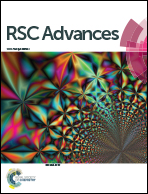Directly printed stretchable strain sensor based on ring and diamond shaped silver nanowire electrodes†
Abstract
In this study, we fabricated a stretchable Silver nanowires (Ag NWs)/PDMS composite strain sensor with arbitrary micro-pattern electrodes using dispensing nozzle printing. In order to ensure a mechanically stable design, we proposed two types of electrodes: patterns of overlapped rings and diamonds. We also demonstrated that the electrical resistance could be modified according to the printing speed because the number of conductive fillers was proportional to the liquid ejection time. We also conducted static simulation for the two geometries to study the effect of the patterns when the strain sensor is stretched. We achieved highly stretchable strain sensor (up to 60% strain) with a suitable electrode design. Based on experimental results, it is expected that directly drawn electronic skin (E-skin) via the printing method can be fabricated with multifunctional sensing abilities in the near future.


 Please wait while we load your content...
Please wait while we load your content...